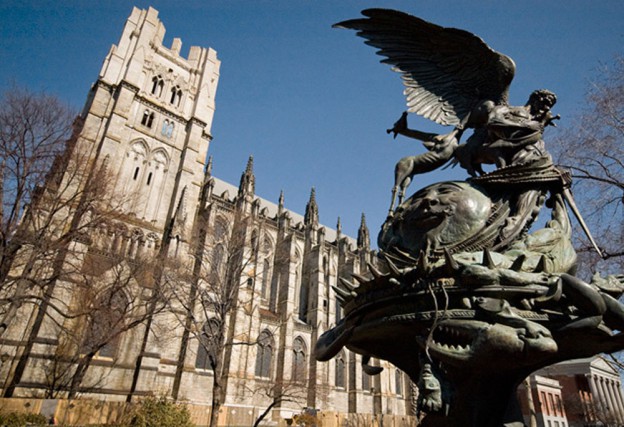By Ben Gittelson
Columbia Daily Spectator
Published November 3, 2011
Archives
Locals Still Waiting for Word on Mohi Historic District
By Casey Tolan
Columbia Daily Spectator
Published November 14, 2011
Make Morningside a Historic District
by Gretchen Borges
Columbia Daily Spectator
Published November 14, 2011
O’Donnell, locals continue to oppose St. John’s expansion
By Casey Tolan and Avantika Kumar
Columbia Daily Spectator
Published April 5, 2012

St. John The Divine
Amsterdam Avenue to Morningside Drive, West 110th to West 113th Streets.;
Cathedral: Heins & LaFarge, 1891–1911, Ralph Adams Cram 1911–42;
St. Faith’s House: John LaFarge, 1909;
Synod House: Ralph Adams Cram,1911–13;
Choir School: Walter Cook and Winthrop A. Welch, 1912–13;
Episcopal Residence: Ralph Adams Cram, 1912;
Open-Air Pulpit: Howells & Stokes, 1913;
Leake and Watts Orphan Asylum: Ithiel Town, 1837–42|
Heins & LaFarge won the design competition for their Byzantine/Romanesque/Gothic cathedral conception. One of its most prominent features is the Guastavino tiled dome, constructed as a temporary roof during fundraising for the massive central crossing tower, which was never completed. The cathedral famously suffered many setbacks, including waning public interest to provide funds, significant design alterations, the replacement of Heins & LaFarge with Ralph Adams Cram, and building hiatuses during two world wars. Despite its uneven developmental history, the cathedral remains a fascinating juxtaposition of styles and construction technologies. Its subsidiary structures were built around the Close in Gothic variations. In spite of being an international icon, the complex remains unprotected by the New York City Landmarks Preservation Commission. In 2007, the cathedral leased the Close’s southeast parcel for the construction of a residential high-rise, and two residential high-rises next to the Cathedral’s north wall were built. The Greek Revival Leake and Watts Orphan Asylum, restored in 2006 and currently the home of the cathedral’s tapestry conservation studio, is Morningside Heights’ oldest extant structure.
The introduction of the subway into Morningside Heights in 1904, coupled with the neighborhood’s magnificent parks and prestigious institutions, led to a frenzy of speculative apartment house construction, attracting middle-class residents who could now commute directly downtown to work. Even before the advent of zoning regulations for land use, developers erected rowhouses and modest apartment buildings on the side streets and grand apartment houses on the avenues, with particularly monumental examples on Riverside Drive, Claremont Avenue and Cathedral Parkway, and mixed-use commercial buildings along Broadway, giving the neighborhood a heterogeneous yet cohesive character. Morningside Heights’ unorthodox yet distinctive sense of place comes from the coexistence of residential and institutional clusters, as exemplified by elegant rowhouses and apartment buildings just steps away from renowned academic institutions and houses of worship.
Today the neighborhood still enjoys this singular sense of place. Its institutions are impressive examples of Beaux-Arts planning and design, including the graceful approach to Grant’s Tomb, the entrance façades of St. John the Divine and Riverside Church aligned with the axes of 112th Street and 122nd Street, and especially Charles McKim’s plan for Columbia University, whose symmetry and axial layout emphasize the monumentality and unity of the surrounding architecture. The residential architecture, though sometimes grand, offers a human scale and balance to the whole neighborhood.

Columbia University
Roughly between Broadway and Amsterdam Avenue, West 114th to West 120th Streets;
Low Library: Charles McKim, 1895–97: New York City Individual and Interior Landmark, ;State and National Registers of Historic Places;
Butler Library: James Gamble Rogers, 1931–34;
Macy Villa/Buell Hall: Ralph Townsend, 1885;
St. Paul’s Chapel: I. N. Phelps Stokes, 1903: New York City Individual Landmark;
Casa Italiana: McKim, Mead & White, 1926–07: New York City Individual Landmark, State ;and National Registers of Historic Places|
Charles McKim designed the campus in the Beaux-Arts style popularized at the 1893 World’s Columbian Exposition. Its focal point is Low Library, designed in the Roman Classical style, with Italian Renaissance–inspired classroom buildings flanking it in the forecourt and rear. Fashioned after the Baths of Caracalla and the Pantheon, the library’s granite dome is the country’s largest. The university outgrew Low Library in the 1920s, and a new library named for then president Nicholas Murray Butler was built on the campus’ southern end. A highlight of the campus is St. Paul’s Chapel, designed in a Lombardic style using the red brick and limestone motif of the campus classroom buildings. The only extant building of the Bloomingdale complex is Macy Villa (currently Buell Hall), which was constructed as a residence for mentally-ill, wealthy male patients. On Amsterdam Avenue is Casa Italiana, a cultural center designed to evoke a Renaissance palazzo.